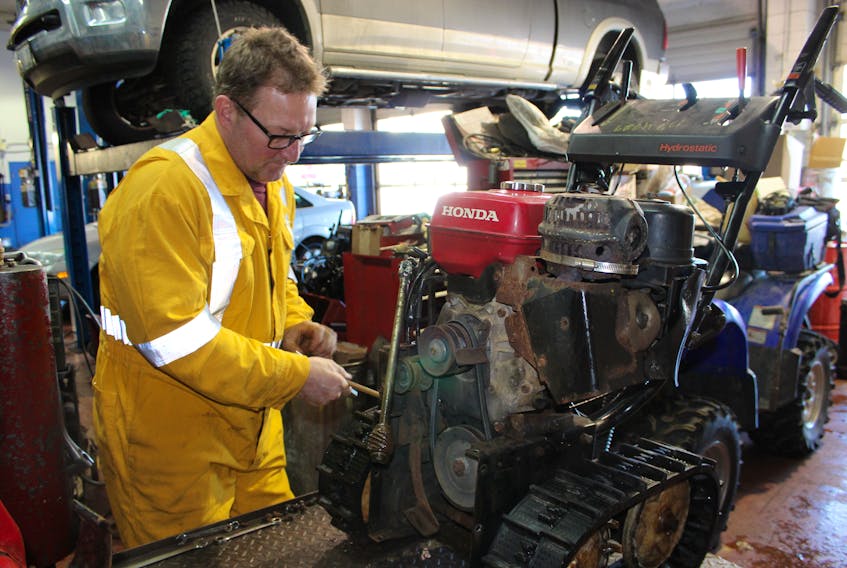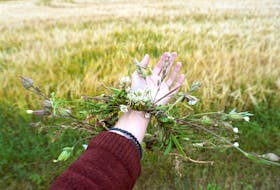ST. JOHN'S, N.L. - If you read the unofficial guide to winter life in this province, a snowblower is a recommended item.
Just ask anyone this winter, especially those who had their snowblowers break down during the heavy and wet snow that has fallen the past few days and were forced to shovel that snow.
Andy Young has done his fair share of small engine and mechanical repairs to snowblowers and was in the midst of fixing one and taking calls on several others during this interview.
Young said his shop, at King’s Bridge Service Station in St. John’s, could be open 24 hours a day, seven days a week if he could manage the workload.
![['Leigh Murray stands beside some of the few remaining snow blowers left in stock at Proudfoot Motors. Snow blowers are in scarce supply in Pictou County this year.']](/media/photologue/photos/cache/snowblowers-2523721_display.jpg)
“We do work on all ages and types of snowblowers,” he said.
“This one here is a transmission problem in an older Honda. This issue is a part with the Honda that wears out after a decade,’’ he added, noting Honda is one of the better snowblowers on the market.
Young said he sees all kinds of repair issues that includes the auger drive, burned and broken belts, cables and gears.
He says many of those things can be avoided if people follow basic operation practices and do regular maintenance.
“You just have to take your time. If you ram your way through something, you are going to burn up a belt or something more serious,’’ he said.
“If you don’t, you are going to have a broken snowblower, along with everyone else.”
He said among the most common things to break on a snowblower are the shear pins, which are there for good reason. Young said if you don’t have those, and things like rocks or pieces of wood get jammed in the auger, you would have bigger issues and bigger repair bills.
“They break off, so your snowblower doesn’t get destroyed,’’ he said.
Keeping the machines running is his speciality, and he said people shouldn’t wait until it snows to make sure it is in tip-top running order.
“You have to keep an eye on the parts. If it is worn, don’t wait to get it fixed. The problem is not going to go away,’’ he said.
“Typically, if something breaks in those situations, it takes something else with it.’’
Snowblower maintenance tips
• Change the spark plug: Disconnect the plug from the lead and remove it with a wrench. If there’s damage or deposits, replace it. If not, pop it back in — securely, but not too tight.
• Inspect the belts: Wear and tear? Cracks? If so, replace them. Tip: snap a photo of the belts before you take them off so you’ll know exactly where they go.
• Give the paddles their due: The auger paddles are the hardest-working parts on a snowblower, so check them often for wear and tear. If they don’t hit the ground anymore, replace them.
• Check the shave plate: This scrapes the snow off your driveway. If it’s worn on a single-stage snowblower, reverse it. For a two-stage snowblower, replace it.
• Flip the skid shoes: These are the adjustable pieces on a two-stage snowblower that let you set the height of your auger. Most are reversible. If yours look worn, flip it over and use the other side, making a note to replace them next year.
• See if the shear pins are damaged: Shear pins connect the auger to the gear case. Did you know they’re meant to break? It’s a safety feature — they’ll break if the auger and gear case are overloaded. Tip: keep extras in the garage.
• Change the Oil: Let the blower warm up to make the oil flow easier. Then turn it off, pull the drain plug and drain the oil into a container. Pop the plug back in and fill the machine with oil.
• Use fresh gas with stabilizer: Fill with fresh gas (you did remember to empty it last season, right?) and make sure to include fuel stabilizer. It will keep the gas fresh longer and help prevent clogs.
Source: Sears Home Services








